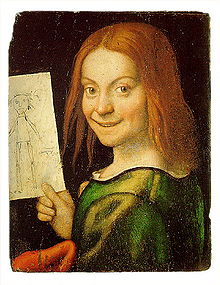กลุ่มอาการแองเกลแมน
| กลุ่มอาการแองเจิลแมน (Angelman syndrome) | |
|---|---|
| ชื่ออื่น | Angelman's syndrome,[1][2] happy puppet syndrome[3] |
 | |
| เด็กหญิงอายุ 5 ขวบที่มีอาการแองเกลแมน ลักษณะที่ปรากฏได้แก่ หัวตาห่างเกิน, สันหัวตาทั้ง 2 ข้างหนาตัวขึ้น (bilateral epicanthic folds), ศีรษะเล็ก, ปากกว้าง และท่าทางดูมีความสุข, ปลายนิ้วมือเรียว มีรอยพับผิดปรกติ และนิ้วหัวแม่มือกว้าง | |
| การออกเสียง | |
| สาขาวิชา | เวชพันธุศาสตร์ |
| อาการ | พัฒนาการล่าช้า, มีความสุขผิดปรกติ, บกพร่องทางสติปัญญา, พูดไม่เป็นภาษา, มีปัญหาการทรงตัวและการเคลื่อนไหว, ศีรษะเล็ก, ชัก[7] |
| การตั้งต้น | สังเกตได้ภายใน 6–12 เดือน[7] |
| สาเหตุ | พันธุกรรม (การกลายพันธุ์ใหม่)[7] |
| วิธีวินิจฉัย | ตามอาการ, การตรวจพันธุกรรม[8] |
| โรคอื่นที่คล้ายกัน | อัมพาตสมองใหญ่, ออทิซึม, กลุ่มอาการเรตต์, กลุ่มอาการเพรเดอร์-วิลลี[8][9] |
| การรักษา | การรักษาตามอาการ[8] |
| พยากรณ์โรค | การคาดหมายคงชีพใกล้เคียงปรกติ[7] |
| ความชุก | 1 ใน 12,000 ถึง 20,000 ของประชากร[7] |
กลุ่มอาการแองเจิลแมน (อังกฤษ: Angelman syndrome, AS) เป็นโรคพันธุกรรมเกี่ยวกับระบบประสาท[7] มีลักษณะเฉพาะคือผู้ป่วยจะมีความบกพร่องทางสติปัญญาและพัฒนาการ การนอนหลับมีปัญหา มีอาการชัก มีการเคลื่อนไหวผิดปรกติ หัวเราะหรือยิ้มบ่อย แลดูมีความสุขผิดปรกติ
กลุ่มอาการแองเจิลแมนเป็นตัวอย่างที่นิยมใช้ทั่วไปของกระบวนการประทับตราทางพันธุกรรม (genomic imprinting) ซึ่งมักเกิดจากการหลุดหาย (deletion) หรือการยับยั้งการทำงานของยีนบนโครโมโซมคู่ที่ 15 ที่ได้รับมาจากแม่ ในขณะที่ยีนบนโครโมโซมคู่ที่ 15 อีกแท่งหนึ่งซึ่งได้รับมาจากพ่อนั้นถูก "ประทับตรา" (imprint) ไว้ทำให้ไม่มีการทำงาน กลุ่มอาการอีกอย่างหนึ่งซึ่งมีความสัมพันธ์ใกล้ชิดกันเรียกว่ากลุ่มอาการพราเดอร์-วิลลี เกิดจากการหายไปของยีนในตำแหน่งเดียวกันซึ่งได้รับมาจากพ่อ โดยยีนของฝั่งแม่ที่มีอยู่ถูกประทับตราไว้
ชื่อเดิมของกลุ่มอาการแองเจิลแมนคือกลุ่มอาการแฮปปี้พัพเพ็ต (happy puppet syndrome, กลุ่มอาการ "หุ่นกระบอกที่มีความสุข") ซึ่งมักถูกถือว่าเป็นการใช้ชื่อที่ไม่สุภาพ เป็นมลทินกับผู้ป่วย จนปัจจุบันกลายเป็นชื่อไม่ได้รับการยอมรับ
บางครั้งผู้ป่วยกลุ่มอาการแองเจิลแมนอาจถูกเรียกว่า แองเจล (angels, นางฟ้า/เทวดา) ส่วนหนึ่งมาจากชื่อโรคและลักษณะภายนอกที่ดูมีความสุขตลอดเวลา
ประวัติ[แก้]

แฮร์รี่ แองเกลแมน (Harry Angelman) ซึ่งเป็นกุมารแพทย์ในวอร์ริงตัน ประเทศอังกฤษ ได้รายงานผู้ป่วยเด็กสามรายที่มีภาวะเช่นนี้ไว้เมื่อ ค.ศ. 1965[8][10] ซึ่งในภายหลังแองเกลแมนได้กล่าวว่าได้เลือกใช้คำว่า "Puppet children" (เด็กหุ่น) เพื่ออธิบายกรณีผู้ป่วยเหล่านี้ว่ามีที่มาจากภาพสีน้ำมันที่เขาได้เห็นขณะไปพักผ่อนในอิตาลี
ประวัติศาสตร์การแพทย์นั้นเต็มไปด้วยเรื่องราวที่น่าสนใจเกี่ยวกับการค้นพบโรคภัยต่าง ๆ เรื่องราวว่าด้วยกลุ่มอาการแองเกลแมนนั้นก็เป็นหนึ่งในเรื่องราวเช่นนั้น ถือเป็นเรื่องบังเอิญโดยแท้ที่เมื่อสามสิบปีก่อน (ประมาณ ค.ศ. 1964) มีเด็กบกพร่องทางสติปัญญาสามคนที่ต้องได้รับไว้รักษาในโรงพยาบาลหลายครั้งในหอผู้ป่วยเด็กของข้าพเจ้าในอังกฤษ พวกเขามีความบกพร่องหลายอย่าง ซึ่งแม้มองเพียงเผินอาจคิดว่าเป็นภาวะคนละภาวะกัน ข้าพเจ้ากลับรู้สึกว่าอาการป่วยของเด็กเหล่านี้มีสาเหตุร่วมกัน การให้การวินิจฉัยนั้นทำจากพื้นฐานทางคลินิกเพียงอย่างเดียวเนื่องจากแม้ทุกวันนี้เทคนิคการตรวจทางห้องปฏิบัติการจะได้รับการพัฒนาไปมากแต่ในตอนนั้นข้าพเจ้าก็ไม่สามารถสร้างข้อสรุปหลักฐานที่เป็นวิทยาศาสตร์ได้ว่าเด็กทั้งสามคนมีความผิดปรกติอย่างเดียวกัน ด้วยเหตุเช่นนี้เองข้าพเจ้าจึงลังเลที่จะเขียนบทความรายงานลงในวารสารการแพทย์ อย่างไรก็ดี เมื่อครั้งที่ข้าพเจ้าได้ไปพักผ่อนในอิตาลี ข้าพเจ้าบังเอิญได้เห็นภาพสีน้ำมันภาพหนึ่งในพิพิธภัณฑ์ Castelvecchio ในเวโรนาชื่อว่า ... เด็กชายกับหุ่นกระบอก ใบหน้าที่ยิ้มแย้มของเด็กชายในภาพร่วมกับข้อเท็จจริงที่ว่าผู้ป่วยเด็กทั้งสามของข้าพเจ้ามีการเคลื่อนไหวผิดปรกติทำให้ข้าพเจ้ามีความคิดที่จะเขียนบทความเกี่ยวกับผู้ป่วยทั้งสามภายใต้หัวเรื่องว่าเด็กหุ่นกระบอก ชื่อนี้ทำให้เหล่าพ่อแม่ทั้งหลายไม่พอใจ แต่ก็เป็นวิธีหนึ่งที่จะรวมเอาผู้ป่วยน้อย ๆ ทั้งสาม ไว้เป็นหมวดเป็นกลุ่มเดียวกันได้ ต่อมาชื่อนี้ก็ถูกเปลี่ยนเป็นกลุ่มอาการแองเกลแมน บทความนี้ได้รับการตีพิมพ์ใน ค.ศ. 1965 และหลังจากที่ได้รับความสนใจเล็กน้อยในช่วงแรกก็ถูกลืมเลือนไปจนกระทั่งช่วงต้นคริสต์ทศวรรษ 1980 นี้เอง
— แองเกลแมน อ้างโดย ชาลส์ วิลเลียมส์[11]
อ้างอิง[แก้]
- ↑ 1.0 1.1 "Angelman syndrome". Lexico.com. as excerpted from the Oxford English Dictionary. คลังข้อมูลเก่าเก็บจากแหล่งเดิมเมื่อ 17 มิถุนายน 2020.
- ↑ 2.0 2.1 2.2 Angelman syndrome in the Merriam-Webster.com Medical Dictionary
- ↑ Winter, Robin M.; Baraitser, Michael (2013). Multiple Congenital Anomalies: A Diagnostic Compendium. Springer. p. 34. ISBN 978-1-4899-3109-2. เก็บจากแหล่งเดิมเมื่อ 5 พฤศจิกายน 2017.
- ↑ Angelman syndrome in the McGraw-Hill Dictionary of Scientific & Technical Terms
- ↑ 5.0 5.1 Angelman syndrome in the American Heritage Medical Dictionary
- ↑ Angelman syndrome in Comprehensive Developmental Neuroscience: Neural Circuit Development and Function in the Heathy and Diseased Brain: Chapter 32.
- ↑ 7.0 7.1 7.2 7.3 7.4 7.5 "Angelman syndrome". ghr.nlm.nih.gov. Genetics Home Reference, National Institutes of Health. พฤษภาคม 2015. เก็บจากแหล่งเดิมเมื่อ 27 สิงหาคม 2016. สืบค้นเมื่อ 28 เมษายน 2017.
- ↑ 8.0 8.1 8.2 8.3 "Angelman Syndrome". rarediseases.org. National Organization for Rare Disorders (NORD). 2015. เก็บจากแหล่งเดิมเมื่อ 13 พฤศจิกายน 2016. สืบค้นเมื่อ 28 เมษายน 2017.
- ↑ "Common Misdiagnoses | FAST". FAST (Foundation for Angelman Syndrome Therapeutics). คลังข้อมูลเก่าเก็บจากแหล่งเดิมเมื่อ 9 ตุลาคม 2019. สืบค้นเมื่อ 10 ตุลาคม 2019.
- ↑ Angelman, Harry (1965). "'Puppet' Children: A report of three cases". Developmental Medicine & Child Neurology. 7 (6): 681–688. doi:10.1111/j.1469-8749.1965.tb07844.x. S2CID 53730099.
- ↑ Williams, Charles A.; Peters, Sarika U.; Calculator, Stephen N. (1 มกราคม 2009). Facts about Angelman Syndrome (PDF) (7th ed.). Angelman Syndrome Foundation. pp. 2–3. สืบค้นเมื่อ 14 พฤษภาคม 2023.
The history of medicine is full of interesting stories about the discovery of illnesses. The saga of Angelman's syndrome is one such story. It was purely by chance that nearly thirty years ago (e.g., circa 1964) three handicapped children were admitted at various times to my children's ward in England. They had a variety of disabilities and although at first sight they seemed to be suffering from different conditions I felt that there was a common cause for their illness. The diagnosis was purely a clinical one because in spite of technical investigations which today are more refined I was unable to establish scientific proof that the three children all had the same handicap. In view of this I hesitated to write about them in the medical journals. However, when on holiday in Italy I happened to see an oil painting in the Castelvecchio Museum in Verona called . . . a Boy with a Puppet. The boy's laughing face and the fact that my patients exhibited jerky movements gave me the idea of writing an article about the three children with a title of Puppet Children. It was not a name that pleased all parents but it served as a means of combining the three little patients into a single group. Later the name was changed to Angelman syndrome. This article was published in 1965 and after some initial interest lay almost forgotten until the early eighties.
แหล่งข้อมูลอื่น[แก้]
- Angelman Syndrome Foundation USA
- Angelman Syndrome Association AUS
- Angelman Syndrome Support Education & Research Trust - UK
- กลุ่มอาการแองเกลแมน ที่เว็บไซต์ Curlie
- Angelman syndrome ใน NIH/UW GeneTests
- Foundation for Angelman Syndrome Therapeutics
| การจำแนกโรค | |
|---|---|
| ทรัพยากรภายนอก |
